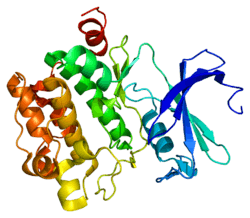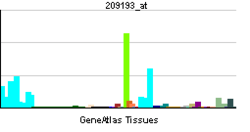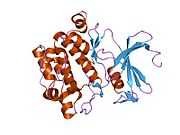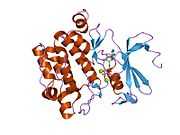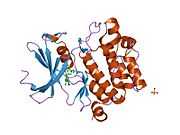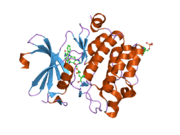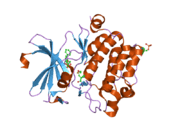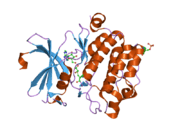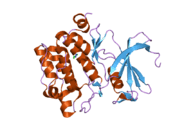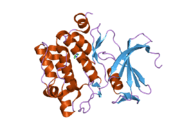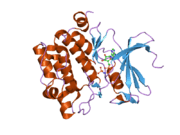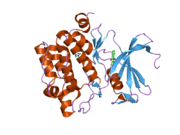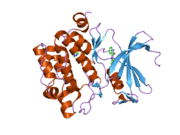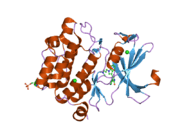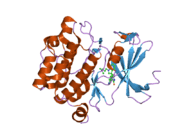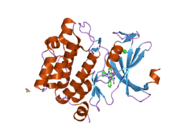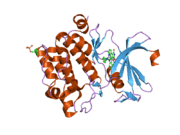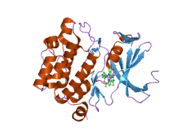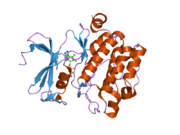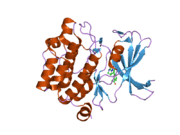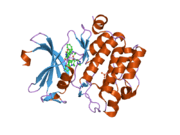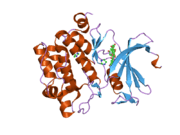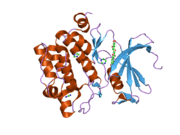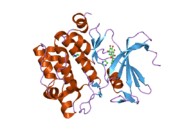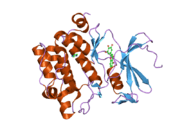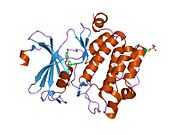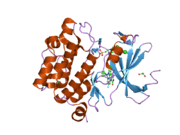PIM1
Proto-oncogene serine/threonine-protein kinase Pim-1 is an enzyme that in humans is encoded by the PIM1 gene.[1][2][3]
Pim-1 is a proto-oncogene which encodes for the serine/threonine kinase of the same name. The pim-1 oncogene was first described in relation to murine T-cell lymphomas, as it was the locus most frequently activated by the Moloney murine leukemia virus.[4] Subsequently, the oncogene has been implicated in multiple human cancers, including prostate cancer, acute myeloid leukemia and other hematopoietic malignancies.[5] Primarily expressed in spleen, thymus, bone marrow, prostate, oral epithelial, hippocampus and fetal liver cells, Pim-1 has also been found to be highly expressed in cell cultures isolated from human tumors.[4] Pim-1 is mainly involved in cell cycle progression, apoptosis and transcriptional activation, as well as more general signal transduction pathways.[4]
Gene
Located on chromosome 6 (6p21.2), the gene encompasses 5Kb of DNA, including 6 exons and 5 introns. Expression of Pim-1 has been shown to be regulated by the JAK/STAT pathway. Direct binding of transcription factors STAT3 and STAT5 to the Pim-1 promoter results in the transcription of Pim-1.[4] The Pim-1 gene has been found to be conserved in dogs, cows, mice, rats, zebrafish and C. elegans. Pim-1 deficient mice have been shown to be phenotypically normal, indicating that there is redundancy in the function of this kinase.[4] In fact, sequence homology searches have shown that two other Pim-1-like kinases, Pim-2 and Pim-3, are structurally and functionally similar.[4] The Pim-1 gene encodes has multiple translation initiation sites, resulting in two proteins of 34 and 44kD.[4]
Protein structure
Human, murine and rat Pim-1 contain 313 amino acids, and have a 94 – 97% amino acid identity.[4] The active site of the protein, ranging from amino acids 38-290, is composed of several conserved motifs, including a glycine loop motif, a phosphate binding site and a proton acceptor site.[4] Modification of the protein at amino acid 67 (lysine to methionine) results in the inactivation of the kinase.[4]
Activation and stabilization
Pim-1 is primarily involved in cytokine signaling, and has been implicated in many signal transduction pathways. Because Pim-1 translation is initiated by STAT3 and STAT5, its production is regulated by the cytokines that regulate the STAT pathway, or STAT factors. These include interleukins (IL-2, IL-3,IL-5, IL-6, IL-7, IL12, IL-15), prolactin, TNFα, EGF and IFNγ, among others.[4] Pim-1 itself can bind to negative regulators of the JAK/STAT pathway, resulting in a negative feedback loop.
Although little is known about the post-transcriptional modifications of Pim-1, it has been hypothesized that Hsp90 is responsible for the folding and stabilization of Pim-1, although the exact mechanism has yet to be discovered.[4] Furthermore, the serine/threonine phosphatase PP2 has been shown to degrade Pim-1.
Interactions
PIM1 has been shown to interact with:
- CBX3,[6]
- CDC25A,[7]
- Heat shock protein 90kDa alpha (cytosolic), member A1,[8]
- NFATC1,[9]
- Nuclear mitotic apparatus protein 1,[10]
- P21,[11]
- SND1[12] and
- RELA.[13]
Other known substrates/binding partners of Pim-1 include proteins involved in transcription regulation (nuclear adaptor protein p100, HP-1, PAP-1 and TRAF2 / SNX6), and regulation of the JAK/STAT pathway (SOCS1 and SOCS3).[4] Furthermore, Pim-1 has been shown to be a cofactor for c-Myc, a transcription factor believed to regulate 15% of all genes, and their synergy has been in prostate tumorigenesis.[14]
Pim-1 is able to phosphorylate many targets, including itself. Many of its targets are involved in cell cycle regulation.
Activates
- Cdc25C (G1/S positive regulator): Activation results in increased G1 → S[4]
- Cdc25C (G2/M positive regulator): Activation results in increased G2 → M[4]
Deactivates
- Bad (Pro-apoptotic protein): Deactivation results in increased cell survival[4]
- CKI (G1/S negative regulator): Deactivation results in increased G1 → S[4]
- C-TAK1 (Cdc25C inhibitor): Deactivation results in increased G2 → M[4]
Clinical implications
Pim-1 is directly involved in the regulation of cell cycle progression and apoptosis, and has been implicated in numerous cancers including prostate cancer, Burkitt’s lymphoma and oral cancer, as well as numerous hematopoietic lymphomas. Single nucleotide polymorphisms in the Pim-1 gene have been associated with increased risk for lung cancer in Korean patients, and have also been found in diffuse large cell lymphomas.[15]
References
- ↑ "Entrez Gene: PIM1 pim-1 oncogene".
- ↑ Domen J, Von Lindern M, Hermans A, Breuer M, Grosveld G, Berns A (June 1987). "Comparison of the human and mouse PIM-1 cDNAs: nucleotide sequence and immunological identification of the in vitro synthesized PIM-1 protein". Oncogene Res. 1 (1): 103–12. PMID 3329709.
- ↑ Meeker TC, Nagarajan L, ar-Rushdi A, Rovera G, Huebner K, Croce CM (June 1987). "Characterization of the human PIM-1 gene: a putative proto-oncogene coding for a tissue specific member of the protein kinase family". Oncogene Res. 1 (1): 87–101. PMID 3329711.
- ↑ 4.0 4.1 4.2 4.3 4.4 4.5 4.6 4.7 4.8 4.9 4.10 4.11 4.12 4.13 4.14 4.15 4.16 4.17 Bachmann M, Möröy T (April 2005). "The serine/threonine kinase Pim-1". Int. J. Biochem. Cell Biol. 37 (4): 726–30. doi:10.1016/j.biocel.2004.11.005. PMID 15694833.
- ↑ "Pim-1 Oncogene". Retrieved 2010-05-24.
- ↑ Koike N, Maita H, Taira T, Ariga H, Iguchi-Ariga SM (February 2000). "Identification of heterochromatin protein 1 (HP1) as a phosphorylation target by Pim-1 kinase and the effect of phosphorylation on the transcriptional repression function of HP1(1)". FEBS Lett. 467 (1): 17–21. doi:10.1016/S0014-5793(00)01105-4. PMID 10664448.
- ↑ Mochizuki T, Kitanaka C, Noguchi K, Muramatsu T, Asai A, Kuchino Y (June 1999). "Physical and functional interactions between Pim-1 kinase and Cdc25A phosphatase. Implications for the Pim-1-mediated activation of the c-Myc signaling pathway". J. Biol. Chem. 274 (26): 18659–66. doi:10.1074/jbc.274.26.18659. PMID 10373478.
- ↑ Mizuno K, Shirogane T, Shinohara A, Iwamatsu A, Hibi M, Hirano T (March 2001). "Regulation of Pim-1 by Hsp90". Biochem. Biophys. Res. Commun. 281 (3): 663–9. doi:10.1006/bbrc.2001.4405. PMID 11237709.
- ↑ Rainio EM, Sandholm J, Koskinen PJ (February 2002). "Cutting edge: Transcriptional activity of NFATc1 is enhanced by the Pim-1 kinase". J. Immunol. 168 (4): 1524–7. doi:10.4049/jimmunol.168.4.1524. PMID 11823475.
- ↑ Bhattacharya N, Wang Z, Davitt C, McKenzie IF, Xing PX, Magnuson NS (July 2002). "Pim-1 associates with protein complexes necessary for mitosis". Chromosoma 111 (2): 80–95. doi:10.1007/s00412-002-0192-6. PMID 12111331.
- ↑ Wang Z, Bhattacharya N, Mixter PF, Wei W, Sedivy J, Magnuson NS (December 2002). "Phosphorylation of the cell cycle inhibitor p21Cip1/WAF1 by Pim-1 kinase". Biochim. Biophys. Acta 1593 (1): 45–55. doi:10.1016/S0167-4889(02)00347-6. PMID 12431783.
- ↑ Leverson JD, Koskinen PJ, Orrico FC, Rainio EM, Jalkanen KJ, Dash AB, Eisenman RN, Ness SA (October 1998). "Pim-1 kinase and p100 cooperate to enhance c-Myb activity". Mol. Cell 2 (4): 417–25. doi:10.1016/S1097-2765(00)80141-0. PMID 9809063.
- ↑ Nihira K, Ando Y, Yamaguchi T, Kagami Y, Miki Y, Yoshida K (April 2010). "Pim-1 controls NF-κB signalling by stabilizing RelA/p65". Cell Death Differ, 17 (4): 689–98. doi:10.1038/cdd.2009.174. PMID 19911008.
- ↑ Wang J, Kim J, Roh M, Franco OE, Hayward SW, Wills ML, Abdulkadir SA (April 2010). "Pim1 kinase synergizes with c-MYC to induce advanced prostate carcinoma". Oncogene 29 (17): 2477–87. doi:10.1038/onc.2010.10. PMC 2861731. PMID 20140016.
- ↑ Kim DS, Sung JS, Shin ES, Ryu JS, Choi IK, Park KH, Park Y, Kim EB, Park SJ, Kim YH (December 2008). "Association of Single Nucleotide Polymorphisms in Pim-1 Gene with the Risk of Korean Lung Cancer". Cancer Res Treat 40 (4): 190–6. doi:10.4143/crt.2008.40.4.190. PMC 2697471. PMID 19688129.
Further reading
- Ragoussis J, Senger G, Mockridge I et al. (1992). "A testis-expressed Zn finger gene (ZNF76) in human 6p21.3 centromeric to the MHC is closely linked to the human homolog of the t-complex gene tcp-11". Genomics 14 (3): 673–9. doi:10.1016/S0888-7543(05)80167-3. PMID 1427894.
- Saris CJ, Domen J, Berns A (1991). "The pim-1 oncogene encodes two related protein-serine/threonine kinases by alternative initiation at AUG and CUG". EMBO J. 10 (3): 655–64. PMC 452698. PMID 1825810.
- Reeves R, Spies GA, Kiefer M et al. (1990). "Primary structure of the putative human oncogene, pim-1". Gene 90 (2): 303–7. doi:10.1016/0378-1119(90)90195-W. PMID 2205533.
- Amson R, Sigaux F, Przedborski S et al. (1989). "The human protooncogene product p33pim is expressed during fetal hematopoiesis and in diverse leukemias". Proc. Natl. Acad. Sci. U.S.A. 86 (22): 8857–61. doi:10.1073/pnas.86.22.8857. PMC 298389. PMID 2682662.
- Telerman A, Amson R, Zakut-Houri R, Givol D (1988). "Identification of the human pim-1 gene product as a 33-kilodalton cytoplasmic protein with tyrosine kinase activity". Mol. Cell. Biol. 8 (4): 1498–503. PMC 363308. PMID 2837645.
- Meeker TC, Nagarajan L, ar-Rushdi A, Croce CM (1988). "Cloning and characterization of the human PIM-1 gene: a putative oncogene related to the protein kinases". J. Cell. Biochem. 35 (2): 105–12. doi:10.1002/jcb.240350204. PMID 3429489.
- Zakut-Houri R, Hazum S, Givol D, Telerman A (1987). "The cDNA sequence and gene analysis of the human pim oncogene". Gene 54 (1): 105–11. doi:10.1016/0378-1119(87)90352-0. PMID 3475233.
- Leverson JD, Koskinen PJ, Orrico FC et al. (1998). "Pim-1 kinase and p100 cooperate to enhance c-Myb activity". Mol. Cell 2 (4): 417–25. doi:10.1016/S1097-2765(00)80141-0. PMID 9809063.
- Mochizuki T, Kitanaka C, Noguchi K et al. (1999). "Physical and functional interactions between Pim-1 kinase and Cdc25A phosphatase. Implications for the Pim-1-mediated activation of the c-Myc signaling pathway". J. Biol. Chem. 274 (26): 18659–66. doi:10.1074/jbc.274.26.18659. PMID 10373478.
- Koike N, Maita H, Taira T et al. (2000). "Identification of heterochromatin protein 1 (HP1) as a phosphorylation target by Pim-1 kinase and the effect of phosphorylation on the transcriptional repression function of HP1(1)". FEBS Lett. 467 (1): 17–21. doi:10.1016/S0014-5793(00)01105-4. PMID 10664448.
- Maita H, Harada Y, Nagakubo D et al. (2000). "PAP-1, a novel target protein of phosphorylation by pim-1 kinase". Eur. J. Biochem. 267 (16): 5168–78. doi:10.1046/j.1432-1327.2000.01585.x. PMID 10931201.
- Mizuno K, Shirogane T, Shinohara A et al. (2001). "Regulation of Pim-1 by Hsp90". Biochem. Biophys. Res. Commun. 281 (3): 663–9. doi:10.1006/bbrc.2001.4405. PMID 11237709.
- Parks WT, Frank DB, Huff C et al. (2001). "Sorting nexin 6, a novel SNX, interacts with the transforming growth factor-beta family of receptor serine-threonine kinases". J. Biol. Chem. 276 (22): 19332–9. doi:10.1074/jbc.M100606200. PMID 11279102.
- Wang Z, Bhattacharya N, Meyer MK et al. (2001). "Pim-1 negatively regulates the activity of PTP-U2S phosphatase and influences terminal differentiation and apoptosis of monoblastoid leukemia cells". Arch. Biochem. Biophys. 390 (1): 9–18. doi:10.1006/abbi.2001.2370. PMID 11368509.
- Pasqualucci L, Neumeister P, Goossens T et al. (2001). "Hypermutation of multiple proto-oncogenes in B-cell diffuse large-cell lymphomas". Nature 412 (6844): 341–6. doi:10.1038/35085588. PMID 11460166.
- Ishibashi Y, Maita H, Yano M et al. (2001). "Pim-1 translocates sorting nexin 6/TRAF4-associated factor 2 from cytoplasm to nucleus". FEBS Lett. 506 (1): 33–8. doi:10.1016/S0014-5793(01)02881-2. PMID 11591366.
- Rainio EM, Sandholm J, Koskinen PJ (2002). "Cutting edge: Transcriptional activity of NFATc1 is enhanced by the Pim-1 kinase". J. Immunol. 168 (4): 1524–7. doi:10.4049/jimmunol.168.4.1524. PMID 11823475.
- Nieborowska-Skorska M, Hoser G, Kossev P et al. (2002). "Complementary functions of the antiapoptotic protein A1 and serine/threonine kinase pim-1 in the BCR/ABL-mediated leukemogenesis". Blood 99 (12): 4531–9. doi:10.1182/blood.V99.12.4531. PMID 12036885.
- Bhattacharya N, Wang Z, Davitt C et al. (2003). "Pim-1 associates with protein complexes necessary for mitosis". Chromosoma 111 (2): 80–95. doi:10.1007/s00412-002-0192-6. PMID 12111331.
| |||||||||||||||||||||||||||||||||||||||||||||||||||||||||||
| |||||||||||||||||||||||||||||||||||||||||||||||||||||||||||||||||||||||||||||||||||||||||||||||||||||||||||||||||||||||||||||||||||||||||||||||||||||||||||||||||
